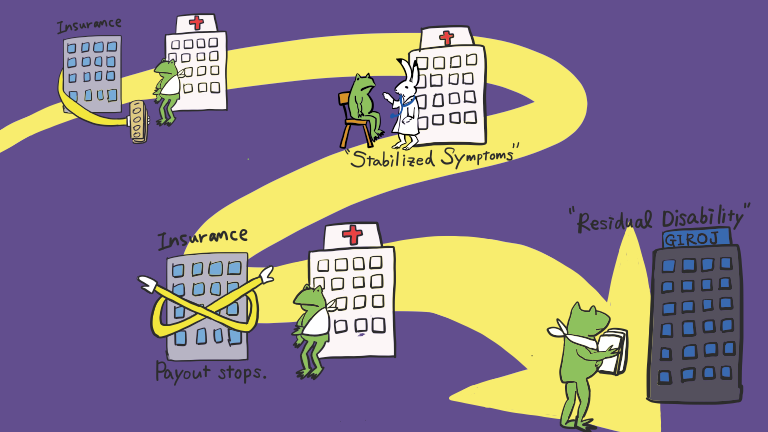Treatment for car accident injury has a period. It depends on the severity of the injury. Sometimes it completely cures, and other times, it’s not cured but only left as it is.
If your doctor considers your injury will not cure anymore even if you continue medical treatment, he assesses your symptom is in stabilization and stops treatment. That sometimes happens in car accident injury cases. It’s called Stabilized Symptoms, which is Shojo-kotei in Japanese. After the doctor's assessment, the next step is applying for compensation benefits for residual disability to GIROJ. If GIROJ admits you are left with a residual disability, the amount of compensation you legally deserve highly increases.
Since the amount of compensation can depend on whether you stop treatment and when to stop it, the timing of when to get diagnosed as “Stabilized Symptoms” is critical in most car accident cases. In this article, we take a closer look at the Stabilized Symptoms and how it affects the process later on.
What does Stabilized Symptoms practically mean in car accident cases?
The word “Stabilized Symptoms” is not used when your symptoms can completely cure. It’s used only when your symptoms are not completely healed yet and considered not to cure in the future as well. Industrial Accident Compensation Insurance in Japan explains the word of “Stabilized Symptoms.” They explain it refers to a state where the symptoms of injuries and diseases are stabilized and where no further medical effect can be expected.
Once your doctor diagnoses your symptoms are in a status of “stabilized,” medical expenses of further treatment is not for compensation anymore. So, insurance companies generally stop compensating for treatment fees. However, after that, if GIROJ admits your left symptoms as residual disability, you will get a right to be compensated for the residual disability. And as you can see in this article about residual disability, the amount of compensation highly increases when you are admitted to be left with a residual disability.
Difference on compensation items before and after getting acknowledgment on Stabilized Symptoms
The amount of compensation depends on when to have a diagnosis of “stabilized symptom.” Before having a diagnosis of stabilized symptoms, the following cost items are for compensation:
- Medical expenses
- Transportation fee to hospitals
- Nursing care fee
- Miscellaneous expenses for hospitalization
- Lost wages
- Consolation money for commuting to hospitals or hospitalization
Once you get a diagnosis of stabilized symptoms, the above cost items are not for compensation, but instead, the following cost items will be for compensation if you are admitted to have residual disability by GIROJ:
- Lost wages for residual disability
- Consolation money for residual disability
- Nursing care fee for the future
Carefully check the financial difference between the two scenarios, which is continuing treatment or getting diagnosed as “Stabilized Symptoms.” Figure out the best timing of getting a diagnosis of stabilized symptoms.
If the insurance company stops paying for medical expenses because they think your injury is stabilized
It’s not that rare an insurance company requires you to get a doctor’s diagnosis of stabilized symptoms just because they don’t want to pay for your medical expenses continually. Even if they stop paying your medical expenses, it’s better to continue the treatment if your pain still remains. Even after they stop payment, if the insurance company finds the treatment was necessary for you afterward, they might possibly cover the medical expenses for the treatment. Although you might have to pay medical expenses by yourself tentatively, we recommend continuing the treatment when you think it’s necessary for your conditions. If the payment for medical expenses is a big burden for you, you can apply for CALI’s payout for the injury. See this article about how to apply for payout from CALI: Applying for payout from CALI.
